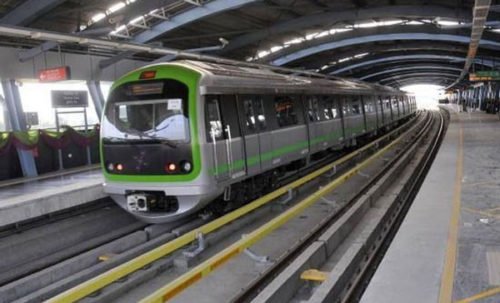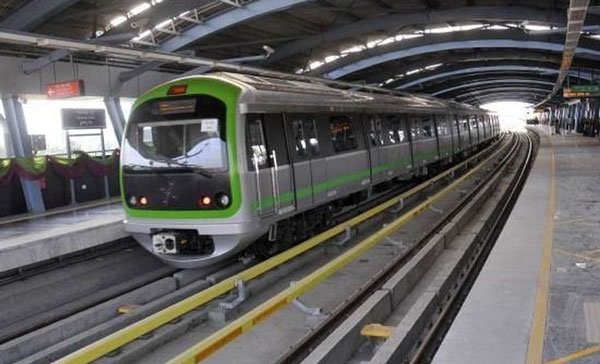
In a major milestone, the first phase of the Bengaluru metro has been completed, with the inauguration of the 11.3-km stretch of the ‘Metro Green Line’ from Mantri Square Sampige Road Station to Yelachenahalli that will provide connectivity between north and south Bengaluru
The first phase of the Bengaluru metro marked its completion, on June 17, 2017, with President Pranab Mukherjee inaugurating the 11.3 km stretch of the ‘Metro Green Line’.
The Green Line, from Mantri Square Sampige Road Station to Yelachenahalli, has four kms underground and 7.3 kms elevated and consists of 10 metro stations. It will provide connectivity between north and south Bengaluru.
With the commissioning of the 11.3 km stretch, the Bangalore Metro Rail Project, also known as ‘Namma Metro’, has a track length of 42.3 kms, with 40 stations in two corridors, namely the east-west and north-south corridors, for Phase-I. The east-west corridor spans 18.1 kms with 17 stations, while the north-south corridor covers 24.2 kms and has 24 stations. The Majestic or Nada Prabhu Kempegowda Station, which is the interchange, is said to be Asia’s biggest station of its kind. The total cost of the first phase of the Bangalore Metro Rail Project is Rs 13,845.01 crores and is expected to meet the ridership of five lakh passengers per day.
Speaking at the inauguration, President Pranab Mukherjee congratulated the centre for implementing metro projects in the country, with the help of state governments, to meet the demands of the growing population. Noting that the first metro project in India was in Kolkata in 1984, followed by the Delhi Metro which was highly successful, he said, “In the next 10-15 years, more than a dozen Indian cities will have their metro projects.” However, he acknowledged India was late to introduce the metro by several decades, primarily because of doubts over its cost-benefit ratio.
Union minister Venkaiah Naidu, who attended the inauguration, said that with the opening of this line, the total metro length operational in the country is 370 kms, in Delhi and NCR, Kolkata, Bengaluru, Chennai, Kochi, Jaipur and Mumbai. “Around 517 kms is under construction in various cities, including Delhi and NCR, Kolkata, Bengaluru, Chennai, Jaipur, Mumbai, Kochi, Ahmedabad, Nagpur and Lucknow and another 522 kms is under consideration,” he said.
Noting that the Ministry of Urban Development has taken certain initiatives to enhance the public transport, Naidu said the new metro policy, will enable greater private participation and innovative financing through ‘value capture financing’ and to conformity to comprehensive mobility plans.
Chief minister Siddaramaiah said rapid economic growth, had brought prosperity to the people of Karnataka, but at the same time it had strained civic infrastructure, particularly that of the transport sector. “Increasing congestion on roads, worsening air quality and related time and health issues, were making the city economically inefficient,” he said, suggesting that projects like ‘Namma Metro’, will have a far-reaching impact on infrastructural, economic and social aspects of the city. “The problem of last mile connectivity has to be addressed through multiple actions, such as good bus services, taxi services, user-friendly pathways, etc.,” the chief minister said.
He said Phase 2 of the ‘Namma Metro Project’ was already under implementation and would add another 72 kms to the existing 42 kms of Phase 1. “An amount of Rs 26,405 crores will be invested on Phase 2. The network, when completed, will reduce traffic congestion and will be able to carry more than 15 lakh passengers per day,” Siddaramaiah said. There are also plans for further expansion of the Namma Metro network, to Kempegowda International Airport and a metro corridor along the Outer Ring Road, the chief minister added.
Started in 2008, the first phase was supported by Japan International Co-operation Agency and Agence Francaise De Developement France, along with state and central governments. An amount of Rs 300 crores was raised by floating bonds, a first in the metro history of the country. The metro project was conceptualised as a viable solution, to reduce the pressure on roadways. Also, Bengaluru has one of the worst air pollution indices among prominent cities in India. In May, the National Green Tribunal directed the authorities to ensure 76 polluting industries around Bengaluru’s Bellandur lake be shut.
Source: Housing.com
Bengaluru metro’s ‘Green Line’ inaugurated






